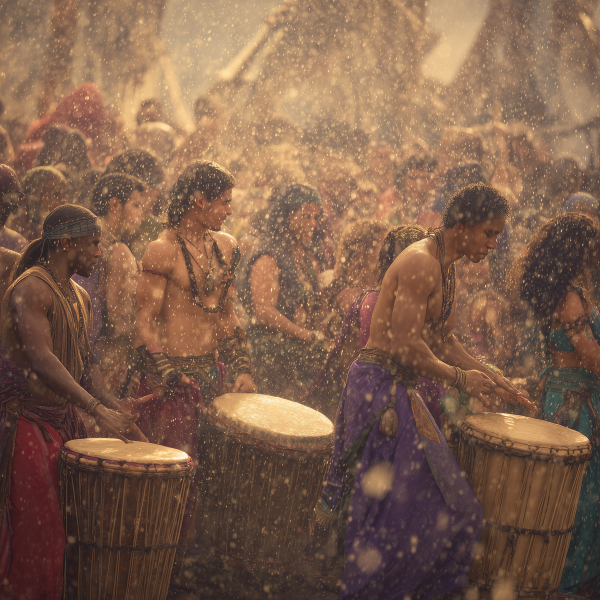Nashar-Thal
Summer is the rainy season in the Velunai Desert, when the annual monsoons blow in off the sea. All the residents of Khaldai celebrate the rite of Nashar-Thal, the Floodkindling, known also Naratalu in old Kalundi, to welcome them. This ancient Kalun festival has since spread to all of Khaldai. In Tabeshi, especially, the start of the rains signals the beginning of both the irrigation of the fields, and the festival season. It is a festival of fertility and renewal, a time of preparing the soil and a time of casting off old arguments and grudges. It is a time of second chances.
Tabeshi is home to the major temple of Okarun, the god of monsoon storms. This floating city, heart of the old Kalun people, hosts the largest and most well known Nashar-Thal festival along the Teshuran River. It has become a site of pilgrimage among the faithful, and people will save up for years to make the trip. Even members of the Mahada customarily attend - not the ruling elders, but the younger folks who want to partake in the weeks-long festivities.
The ritual itself would be simple enough if not for the use of Sharum fruit to induce the spiritually euphoric trance known as Neshara. It is a rite of communal drumming and dance to welcome the life-giving rains back. Afterward, the parties begin, with feasting and music for days. Dried flower petals from the last harvest are thrown by participants. Traditional sweets like Qazhar Figs, Sunfire Cakes, and tangy, sweet Julbahr slices are sold by vendors alongside the usual street food offerings. This sense of celebration and jubilance will extend throughout the three week rainy period.
Execution
The ritual of Nashar-Thal begins with each celebrant bringing a small offering for Okarun, a thanks gift for the return of the god and the rains. This can be anything from coins or food to small handicrafts. Often children on the cusp of adulthood will bring a beloved toy. After the offering is made, each participant receives flower seeds to plant in the temple garden, symbolizing new goals or dreams that they wish to bring forth throughout the year. After the planting, the children are given figs or other dried fruit to eat. Adult worshippers receive one of the highly guarded and sacred Sharum fruit to consume for the heart of the ritual.
All participants will gather in the largest square or open area in their settlement, to perform the Karunara, the “Rhythm That Calls.” Drummers stand on the outskirts of the area, waiting. The lead priest will lead the crowd in creating sound, starting with a soft whisper from the rubbing of hands together. The sounds progress to tapping noises, like the fall of gentle rain, building louder and louder. The drummers join in as the worshippers take over the sound with claps and stomps, sounding like a huge thunderstorm. The celebrants will whirl and dance as they build the sound, letting the state of Neshara overtake them as they bring the rains forth with rhythm and dancing.



Comments